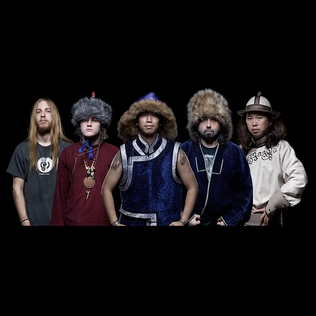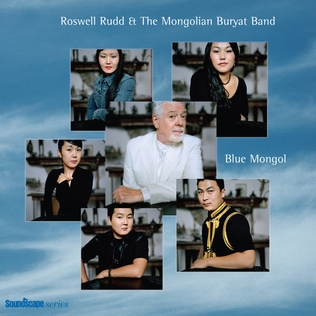
Music of Russia denotes music produced from Russia and/or by Russians. Russia is a large and culturally diverse country, with many ethnic groups, each with their own locally developed music. Russian music also includes significant contributions from ethnic minorities, who populated the Russian Empire, the Soviet Union and modern-day Russia. Russian music went through a long history, beginning with ritual folk songs and the sacred music of the Russian Orthodox Church. The 19th century saw the rise of highly acclaimed Russian classical music, and in the 20th century major contributions by various composers such as Igor Stravinsky as well as Soviet composers, while the modern styles of Russian popular music developed, including Russian rock, Russian hip hop and Russian pop.
Kyrgyz music is nomadic and rural, and is closely related to Turkmen and Kazakh folk forms. Kyrgyz folk music is characterized by the use of long, sustained pitches, with Russian elements also prominent.

Music is an integral part of Mongolian culture. Among the unique contributions of Mongolia to the world's musical culture are the long songs, overtone singing and morin khuur, the horse-headed fiddle. The music of Mongolia is also rich with varieties related to the various ethnic groups of the country: Oirats, Hotogoid, Tuvans, Darhad, Buryats, Tsaatan, Dariganga, Uzemchins, Barga, Kazakhs and Khalha.

The morin khuur, also known as the horsehead fiddle, is a traditional Mongolian bowed stringed instrument. It is one of the most important musical instruments of the Mongol people, and is considered a symbol of the nation of Mongolia. The morin khuur is one of the Masterpieces of the Oral and Intangible Heritage of Humanity identified by UNESCO.

The culture of Mongolia has been shaped by the country's nomadic tradition and its position at the crossroads of various empires and civilizations. Mongolian culture is influenced by the cultures of the Mongolic, Turkic, and East Asian peoples, as well as by the country's geography and its history of political and economic interactions with other nations.
The igil is a two-stringed Tuvan musical instrument, played by bowing the strings. The neck and lute-shaped sound box are usually made of a solid piece of pine or larch. The top of the sound box may be covered with skin or a thin wooden plate. The strings, and those of the bow, are traditionally made of hair from a horse's tail, but may also be made of nylon. Like the morin khuur of Mongolia, the igil typically features a carved horse's head at the top of the neck above the tuning pegs, and both instruments are known as the horsehead fiddle.

Inner Mongolia is an autonomous region of China, with traditions related to Tuvan music and Mongolian music. Popular musicians including the yangqin player Urna Chahar-Tugchi, formerly of Robert Zollitsch’s Gaoshan Liushui, a world music ensemble. The singer-songwriter Tengger has been well known throughout China since his 1986 hit "I am a Mongolian" ; he has since formed a band called Blue Wolf.
The musical traditions of Central Asia mirror the immense diversity found in the cultures and populations residing in the region. Principal instrument types are two- or three-stringed lutes, the necks either fretted or fretless; fiddles made of horsehair; flutes, mostly sige at both ends and either end-blown or side-blown; and jew harps, mostly metal. Percussion instruments include frame drums, tambourines, and kettledrums. Instrumental polyphony is achieved primarily by lutes and fiddles.
The music of Kalmykia, a national republic within Russia, has roots in the musical culture of the Oirats. Traditional instruments include the dombra, which is used to accompany dance music. The state folk ensemble Tulpan was formed in 1937 to promote traditional Kalmyk music.
The long song is one of the central elements of the traditional music of Mongolia. This genre is called "Long song" not only because the songs are long, but also because each syllable of text is extended for a long duration. A four-minute song may only consist of ten words. Certain long songs such as Uvgin shuvuu khoyor, also known as Jargaltain delger take up to three hours to sing at full length, with all thirty-two stanzas. Lyrical themes vary depending on context; they can be philosophical, religious, romantic, or celebratory, and often use horses as a symbol or theme repeated throughout the song. Eastern Mongols typically use a Morin khuur as accompaniment, sometimes with a type of indigenous flute, called limbe. Oirat groups of the Western Mongols traditionally sing long songs unaccompanied or accompanied with the Igil.

Egschiglen are a Mongolian folk band, formed in Ulan Bator in 1991. In English, Egschiglen means "Beautiful Melody", and they are one of very few traditional Mongolian bands to have become internationally popular.

Namgar is a 4-piece music group that performs traditional Buryat and Mongolian music.
Altan Urag is a Mongolian folk rock band. Formed in 2002, the band's musical style combines traditional Mongolian and contemporary influences. They're considered to be the pioneers of mongolian folk-rock.
Biyelgee or Bii, is a unique form of dance, originated from the nomadic way of life.

Tengger Cavalry was a heavy metal band originated from Inner Mongolia and Beijing and formerly based in New York state and Texas. They combine elements of the traditional music of Central Asia and music of Mongolia with heavy metal into a kind of folk metal that Billboard and CNN refer to as nomadic folk metal.
Myagmarsürengiin Dorjdagva ; 1986) is a long-song singer from Mongolia and an independent long-song researcher. In 2007-2021, he served as a researcher at the International Institute for the Study of Nomadic Civilizations (IISNC), an international institution established upon the initiative and support of UNESCO in 1998.
Bukhchuluun Ganburged, also known as Bukhu, is a Mongolian Australian virtuoso throat-singer and Morin Khuur player.

Epic poetry, or tuuli in Mongolian, is an important genre of Mongol oral literature, with features reminiscent of Germanic alliterative verse. The two most well-known epics are the Jangar and the Geser. These tuuli are commonly sung with instruments such as the Morin khuur and the Tovshuur (lute). Most epics deal with topics of the history of the Mongols, their ideal worlds and heroes, and the acquisition of new lands. Epics are performed mostly as celebrations or during important events. Mongol epic poetry has, as of 2009, been on the UNESCO List of Intangible Cultural Heritage in Need of Urgent Safeguarding.

Blue Mongol is an album by trombonist Roswell Rudd and the Mongolian Buryat Band, a five-member ensemble led by Mongolian vocalist Badma Khanda, featuring horse-head fiddle and bass, instruments resembling zither, dulcimer, and flute, and a throat singer. It was recorded in 2005 at Nevessa Production in Saugerties, New York, and was released by Sunnyside Records later that year. The album is a continuation of the cross-cultural experiments that Rudd began pursuing with 2002's Malicool.









